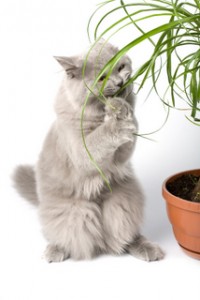 Cats and kittens enjoy all kinds of plants for their play-time, camouflage, and nibbling potential. In fact, there are few plants that are safe from our feline friends, whether they live inside or outside. However, there are plants that we need to protect our cats from.
Cats and kittens enjoy all kinds of plants for their play-time, camouflage, and nibbling potential. In fact, there are few plants that are safe from our feline friends, whether they live inside or outside. However, there are plants that we need to protect our cats from.
Beautiful, But Deadly, Blooms
Most of us don’t give a second thought to the toxicity of the plants in and around our homes. Our focus tends to be on the beauty they provide and the maintenance they may need. Having animals in our lives means our diligence for their safety should extend to our houseplants. For example, all lilies are toxic to cats. Lilies can cause nausea, kidney failure, and death. We may enjoy the beautiful appearance of the blooms or their intoxicating fragrance, but the possibility of losing our furry friend to an avoidable and painful end is enough reason to keep these plants out of our home. If Kitty goes outdoors sometimes, it’s a good idea to refrain from planting any toxic plants in your yard, too.
Popular Plants, Poisonous Properties
Below is a partial list of common houseplants that are known to be toxic to cats.
•Aloe Vera
•Amaryllis
•Narcissus
•Eucalyptus
•Members of the Fern family
•Nightshades
•Autumn Crocus
•Baby’s Breath
•Members of the Lily family
•Foxglove
•Peony
•Geranium
•Periwinkle
•Poinsettia
While some of the above mentioned plants seem harmless, it’s important to consider your cat’s personality. Is she a kitten learning about her world? Is your cat older with a penchant for chewing plant life? Perhaps she doesn’t seem concerned with greenery but there are gaps in your favorite ficus that indicate otherwise. If leaves are missing and Fluffy has been vomiting, chances are she’s nibbling while you’re asleep. If she’s lethargic, nauseous, or if she seems confused, plants may be the culprit.
Sensible Options
Kitty came to live with you after you bought a beautiful red poinsettia. What are your options? You could do the unthinkable and part with the flower or the feline, or you could make your home a safe environment for them both. First of all, keep the cat and the plant separate. This may mean keeping the plant in a china cabinet or decorative cloche. Placing your prized plant in an out of the way location, such as on the top of the refrigerator, might help. Secondly, purchase safe plants for your cat, such as catnip or wheatgrass. Giving your cat access to safe plants to chew can help divert her attention from those that are dangerous. Finally, spend quality time with your cat. Don’t assume she doesn’t want to play or cuddle just because felines are known for being aloof. Behavior like houseplant consumption may be a sign of boredom, loneliness, or a developing health issue.
Your home does not have to be devoid of plant life. Keeping dangerous plants out of kitty’s reach and keeping her busy can enrich her living environment and give you more years of enjoyable cat companionship.